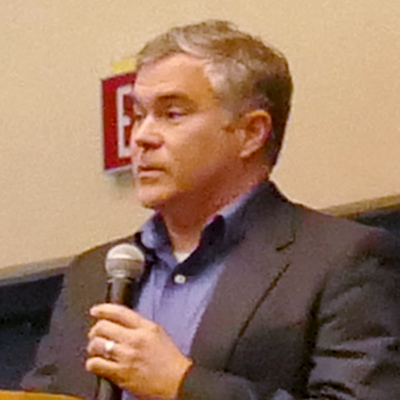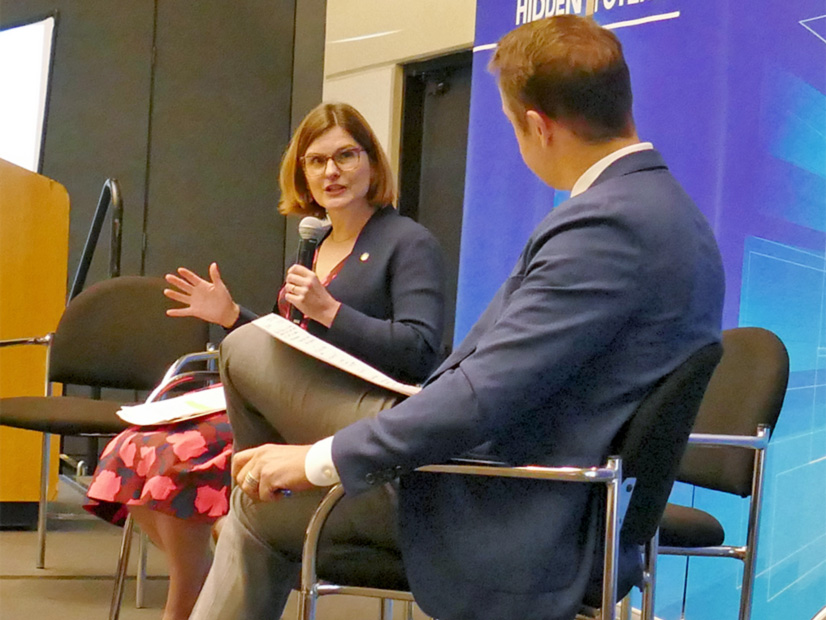DALLAS — Grid-enhancing technologies (GETs) took center stage last week at a WATT Coalition summit on ways to wring efficiencies out of existing transmission facilities. Held in conjunction with the May 23-25 Distributech/PowerGen International Tradeshow, the summit laid out actions utilities can take to optimize the existing grid and transition to a decarbonized economy.
“Grid-enhancing technologies could save U.S. energy customers billions of dollars every year,” WATT (Working for Advanced Transmission Technologies) Coalition Executive Director Rob Gramlich said, setting the tone. “Grids in Europe, Australia and South America are tapping into these benefits, but the U.S. is lagging. U.S. electricity customers pay the price for inaction on grid-enhancing technologies, and it’s time to fix that.”
The summit focused on three primary technologies:
- Dynamic line ratings (DLRs) that adjust ratings based on actual weather conditions, including ambient temperature and wind, in conjunction with real-time monitoring of line loading;
- Advanced power flow controls that inject voltage to increase or decrease resistance, pushing power off overloaded facilities or pulling it on to under-used facilities; and
- Topology optimization, which automatically re-routes flow around congestion while respecting reliability criteria.
FERC Commissioner Allison Clements compared GETs to the early days of VHS tapes and web search engines.
“I think we’re all here because we’re hopeful that this is the future we see,” she said. “Everyone makes an iPhone joke, but that transition happened through a heavily regulated industry. How do we make the changes that provide for those competitive forces to take hold [on the grid]?”
Clements said GETs have been top of the mind at the commission for some time. She pointed to FERC’s December ruling that requires all transmission providers to use ambient-adjusted ratings to evaluate near-term transmission service (RM20-16). (See FERC Orders End to Static Tx Line Ratings.)
In February, the commission also opened an inquiry on whether dynamic line ratings should be incorporated in ratings as well (AD22-5). (See FERC Opens Inquiry on Dynamic Line Ratings.)
Then there’s FERC’s April Notice of Proposed Rulemaking on regional transmission planning requiring consideration of DLRs using advanced power flow control (RM21-17). (See FERC Issues 1st Proposal out of Transmission Proceeding.)
“So, there’s a lot of opportunities,” Clements said. “But it’s very far from … that more seamless platform upon which all these services could be of interest.”
Incentives for GETs
Stacey Crowley, CAISO’s vice president of external affairs, said the evolution of the grid has accelerated with the increasing integration of renewables.
“The operators are learning how to work in a different world,” Crowley said. “We continue to look at all types of technology when we go through our transmission planning process. We’ve had a couple of occasions [in which] we have approved projects that were pretty simple technology, smart wires, data storage as a transmission asset and a couple other things.
“We need to see more of that. [We need] transmission owners … to see the value and find a way for that to work in our business model,” she said.
“In my career, I never saw an infrastructure project I wanted to say no to,” said former FERC and Texas Public Utility Commission chair Pat Wood, now CEO at Hunt Energy Network. “The nice thing about where we are now with the transition to a cleaner and more decarbonized grid is that you need plenty of … plain ol’ transmission service. We need that in spades.”
Wood noted that two of his successors on the PUC, Commissioners Will McAdams and Jimmy Glotfelty, have taken a keen interest in DLRs and ambient line ratings. “I’m happy to see that with this issue, which we knew about when I was at FERC, but we didn’t quite know what to do with it.”
Gramlich, who served with Alison Silverstein as aides to Wood at FERC, said the three often talked about carrots and sticks when discussing how to encourage changes.
“We need carrots and sticks and orange sticks,” Gramlich said. “It’s really important to make sure that there’s incentives as well as the planning requirements” because requirements can be overly prescriptive. “Who’s to say where’s the exact transmission facility to deploy — what technology or what time and in what degree?”
He called for action “very soon” on interconnections. “That’s another area where GETs can come in.”
Addressing Congestion
Participating on a panel of renewable developers discussing the cost of curtailments, Enel Green Power’s Betsy Beck recalled a GETs presentation she saw almost 10 years ago. “I just remember thinking how perfectly built this technology was to deal with [curtailment and congestion] issues that we were starting to face then. [The issues have] really grown and exacerbated since then,” she said.
“Seeing deployment and case studies out there … is really exciting. … These technologies could not come at a better time.”
“Transmission bottlenecks can kill your project,” Invenergy’s Venkata Ajay Pappu said. “You have wind and solar being curtailed because of the constraints that you’re seeing on the system on multiple 345-kV paths. We’re talking about not just developers not being able to build and deliver the power but also future savings back to the ratepayers.”
“We’re now actively thinking about creative ways to meet, to make sure that we meet our renewable energy goals. It’s our view that all options need to be on the table,” Amazon Web Services’ Craig Sundstrom said. “We are driving as much renewable energy deployment on the grid as we can to offset our load, but we also have a significant load and we are major customers. [To have] a proactive and productive discussion [with utilities] around grid modernization is something that we would welcome.”
RTOs, Utilities Weigh In
Grid operator and utility representatives agreed GETs will play a key role in integrating renewable resources. The RTOs and ISOs may be generation agnostic, as SPPs Casey Cathey said, but they also follow the markets. “Obviously, the market is moving towards renewables,” he said.
Cathey asked the audience to imagine themselves as a CEO out to improve existing assets, saying, “If you can extend the value of the transmission system that you already have, then you made a good call as a CEO.”
 Casey Cathey, SPP | © RTO Insider LLC
Casey Cathey, SPP | © RTO Insider LLCWith 14,000 wind turbines totaling 31 GW across its 14-state footprint, SPP has a lot of existing assets. A 2009 study forecast wind accounting for 40% of the RTO’s fuel mix. Today, wind penetration regularly eclipses 70% and has hit as much as 90%.
“We export to MISO, but by and large, a lot of our renewables sink within us,” Cathey said. “When you see 100 [GW in the interconnection queue], that’s actually pushing the bounds a bit. There’s a massive amount of benefit” with GETS.
National Grid’s Babak Enayati said the grid operators need to move quickly to take full advantage of GETs.
“We’re going to have to adapt and adapt quickly to get everything that we want done in the next three or five years,” he said.
Enayati said two roadblocks must first be resolved: the slow pace of adopting solutions and the planning process.
“The [RTOs’ and ISOs’] process of adopting DLR solutions has been going slow because they have their own concerns with … upgrades and how all that data will be adopted and accepted by their operations,” he said. “The other thing is the planning practice so we can quickly move towards combined solutions and merge solutions, like DLR plus power flow control. … Then we’re going to see a significant shift.”



